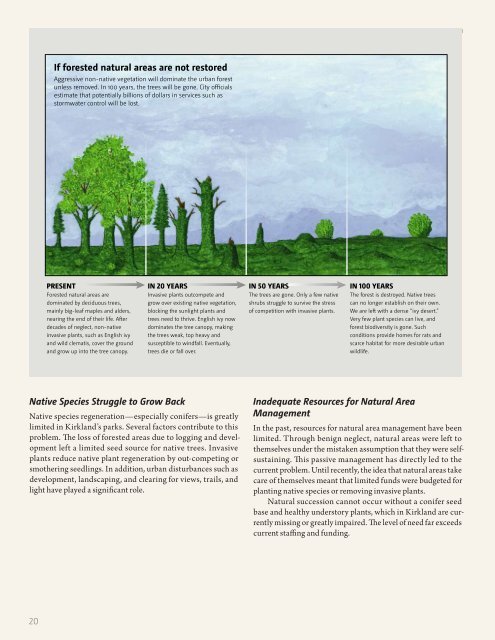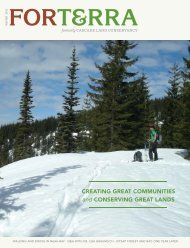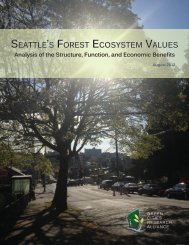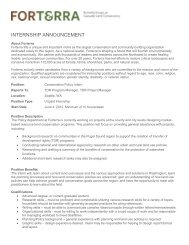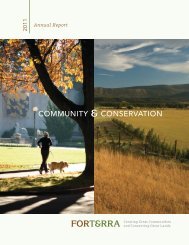Green <strong>Kirkland</strong> PartnershipIf forested natural areas are not restoredAggressive non-native vegetation will dominate the urban forestunless removed. In 100 <strong>year</strong>s, the trees will be gone. <strong>City</strong> <strong>of</strong>ficialsestimate that potentially billions <strong>of</strong> dollars in services such asstormwater control will be lost.PRESENT<strong>Forest</strong>ed natural areas aredominated by deciduous trees,mainly big-leaf maples and alders,nearing the end <strong>of</strong> their life. Afterdecades <strong>of</strong> neglect, non-nativeinvasive plants, such as English ivyand wild clematis, cover the groundand grow up into the tree canopy.IN YEARSInvasive plants outcompete andgrow over existing native vegetation,blocking the sunlight plants andtrees need to thrive. English ivy nowdominates the tree canopy, makingthe trees weak, top heavy andsusceptible to windfall. Eventually,trees die or fall over.IN YEARSThe trees are gone. Only a few nativeshrubs struggle to survive the stress<strong>of</strong> competition with invasive plants.IN YEARSThe forest is destroyed. Native treescan no longer establish on their own.We are left with a dense “ivy desert.”Very few plant species can live, andforest biodiversity is gone. Suchconditions provide homes for rats andscarce habitat for more desirable urbanwildlife.Native Species Struggle to Grow BackNative species regeneration—especially conifers—is greatlylimited in <strong>Kirkland</strong>’s parks. Several factors contribute to thisproblem. The loss <strong>of</strong> forested areas due to logging and developmentleft a limited seed source for native trees. Invasiveplants reduce native plant regeneration by out-competing orsmothering seedlings. In addition, urban disturbances such asdevelopment, landscaping, and clearing for views, trails, andlight have played a significant role.Inadequate Resources for Natural AreaManagementIn the past, resources for natural area management have beenlimited. Through benign neglect, natural areas were left tothemselves under the mistaken assumption that they were selfsustaining.This passive management has directly led to thecurrent problem. Until recently, the idea that natural areas takecare <strong>of</strong> themselves meant that limited funds were budgeted forplanting native species or removing invasive plants.Natural succession cannot occur without a conifer seedbase and healthy understory plants, which in <strong>Kirkland</strong> are currentlymissing or greatly impaired. The level <strong>of</strong> need far exceedscurrent staffing and funding.<strong>20</strong>
<strong>20</strong>-Year <strong>Forest</strong> <strong>Restoration</strong> <strong>Plan</strong>Current StaffingThe Parks and Community Service department has eight fulltimeemployees (FTE) horticultural staff members. Togetherwith seasonal workers and students, these eight staff do most<strong>of</strong> the on-the-ground parks maintenance—mowing, restroomcleaning, athletic field maintenance, litter and other generalduties. Only one staff member, the Senior Grounds and Urban<strong>Forest</strong>er, works to remove invasive plants and restore naturalhabitats. This FTE spends less than 1% <strong>of</strong> the position on thistask.The Park Operations Manager is the primary contact forenvironmental stewardship and restoration <strong>of</strong> <strong>Kirkland</strong> parks.This FTE oversees organization and guidance <strong>of</strong> volunteers.In April <strong>20</strong>07, Parks hired an Education and OutreachSpecialist to help increase volunteer participation and investmentin natural area restoration through the Green <strong>Kirkland</strong>Partnership. This staff member is a temporary (1 <strong>year</strong>) 0.5 FTEposition.From the <strong>Plan</strong>ning Department, the Urban <strong>Forest</strong>er providesa broad range <strong>of</strong> city activities, but only about 5% <strong>of</strong> the 0.5FTE position is for natural areas. Most <strong>of</strong> the Urban <strong>Forest</strong>er’stime is dedicated to permitting and private property matters.The Public Works Department is responsible for habitat restorationalong city streams and other significant water bodies,such as lakes. Most staff in the Public Works Department incorporatenatural area issues in their work. However, currently nostaff is entirely devoted to natural areas.The Public Grounds Division is responsible for removinginvasive plant species along city trails, paths, and rights-<strong>of</strong>-way.Staff currently consists <strong>of</strong> three FTE staff, one temporary FTE, a0.5 FTE field arborist, and several seasonal workers. The arboristworks with trees in rights-<strong>of</strong>-way and on public grounds (fire stations,<strong>City</strong> Hall, and turf medians).The Public Grounds Supervisor is responsible for establishingstewardship practices in city rights-<strong>of</strong>-way and publicgrounds. Stewardship practices include removing invasiveplants, limiting pesticide use and selecting the appropriateplants. There is no dedicated staff position to stewardship <strong>of</strong>forested natural areas.FundingIn addition to the <strong>City</strong>’s general fund⎯which supports currentstaffing levels⎯funding has been dedicated through the6-<strong>year</strong> capital improvement budget <strong>of</strong> $50,000 annually to Green<strong>Kirkland</strong> Partnership program management and restorationactivities.Additional funding for natural area restoration isderived from grants such as the King Conservation District,Conservation Futures, Washington Wildlife and RecreationCoalition (WWRC) and the King County Department <strong>of</strong>Natural Resources. While grant funding is adequate for specificprojects, these sources are not stable, long-term fundingsources that will allow <strong>Kirkland</strong> to carry out a long-term stewardshipand restoration program.VolunteersSince <strong>20</strong>05, 1,500 volunteers have contributed 4,700 hours tonatural area restoration. These volunteers have pulled invasivesincluding ivy, holly, Scot’s broom and blackberry, picked up litter,planted native species, and helped with other maintenancetasks. At the national volunteer rate <strong>of</strong> $18.77 per hour, volunteerhours account for $88,219 in labor over the last 3 <strong>year</strong>s. However,with 372 acres <strong>of</strong> forested natural areas to restore, invasive speciesgrowth will quickly outpace these efforts. Volunteer hoursmust significantly increase if we are to reverse the decline <strong>of</strong><strong>Kirkland</strong>’s forests over the next <strong>20</strong> <strong>year</strong>s. With long-term communityinvestment, our forested natural areas can be restoredand sustained long into the future as a high-quality capitalasset.21


